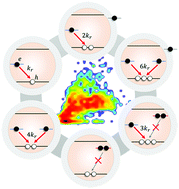Non-excitonic defect-assisted radiative transitions are responsible for new D-type blinking in ternary quantum dots†
Abstract
This work addresses the issue of dark states formation in QDs by cooperative excitonic and intrinsic defect-assisted radiative transitions. Here we refer to the observed blinking as D-type to distinguish it from purely excitonic types. It is shown experimentally that defect-assisted radiative relaxations in a single I–III–VI QD result in atypical blinking characteristics that cannot be explained on the basis of charged exciton models. In addition to the excitonic channel, it has been proposed that defect-assisted kinetics can also form blinking patterns. Two conditions for the formation of dark states have been identified which are related to correlation and competition when considering photons emitted from bright defects. Two transition schemes have therefore been proposed. The first transition scheme includes time-correlated trapping of more than one electron at a single trap centre. This is used to simulate variations in the defect's charge state and switching between radiative/nonradiative transitions. The latter scheme, on the other hand, involves uncorrelated trapping and radiative relaxations from two different types of defects (competition). Both schemes are seen to play an equal role in radiative processes in I–III–VI QDs. Considered together, the proposed models can reflect the experimental data with very good accuracy, providing a better understanding of the underlying physics. An important implication of these schemes is that dark states formation doesn’t have to be limited to mechanisms that involve charged excitons, and it may also be observed for independent defect assisted kinetics. This is especially valid for highly defected or multinary QDs.



 Please wait while we load your content...
Please wait while we load your content...